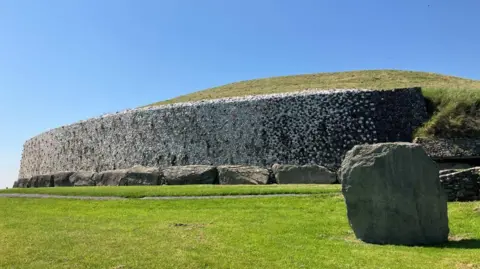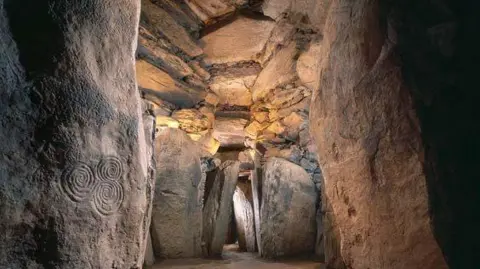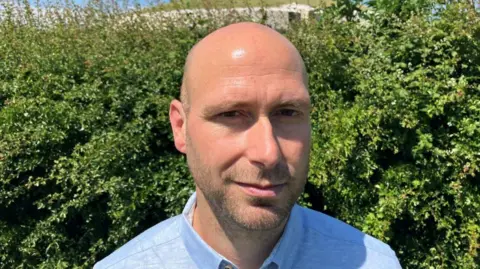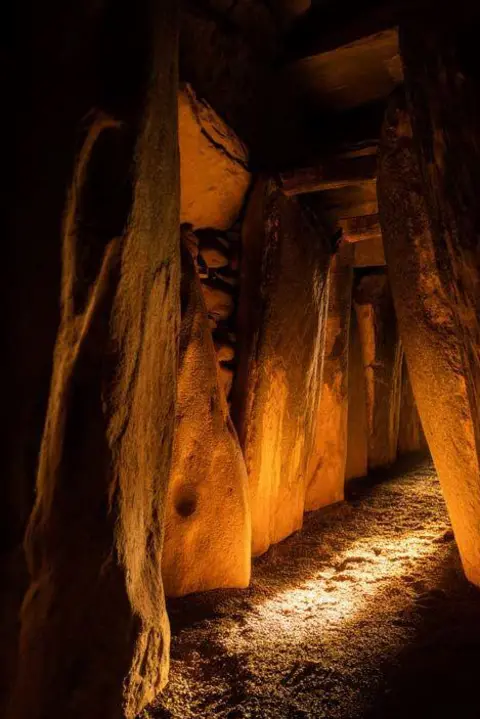Ancient Irish tomb not just for social elite, say researchers
 BBC
BBCBurial at an ancient Irish passage tomb in County Meath may not have been confined to the social elite, according to a new research paper.
It has long been believed that burial at the Newgrange tomb was the preserve of kings and other dignitaries, who represented a dynasty that practised incest.
However, the new paper, published by researchers from University College Dublin (UCD), says this may not be the case.
Associate Professor of archaeology Neil Carlin said suggestions of "an incestuous ruling elite in Stone Age Ireland did not match our understanding of society at this time, it did not fit the evidence very well."
 National Monuments Service, Government of Ireland
National Monuments Service, Government of IrelandThe tomb is a Neolithic monument constructed by stone age farmers more than 5000 years ago in the Boyne Valley.
It is also part of a network of several prehistoric monuments in an area which is recognised as a UNESCO World Heritage Site.
No 'King' of Newgrange
"We now have some really great examples of monuments elsewhere in Europe that contain people with very close biological ties - parents, children, grandparents etc," said Associate Professor Jessica Smyth, also from UCD.
"This sort of aDNA (ancient DNA) evidence is much closer to the idea of a lineage or dynasty. We do not see this evidence in Irish passage tombs."
The findings also claim that no other incestuous unions have been identified in Neolithic Ireland and Britain, and that there is a lack of evidence for inbreeding across prehistoric Europe.
They also say the evidence found at the site does not support the existence of a 'King' of Newgrange or any hereditary power or dynasty with a shared ancestry.
"People were definitely being selected for burial in passage tombs - the whole community does not end up in these monuments.
"However, we don't know the reasons behind this selection, and why they were thought to be special," said Ms Smyth.
"Unlike today, bodies don't tend to be buried 'whole' or 'intact' in this time period. Before they end up in megalithic monuments, bodies are broken down, sometimes cremated and even circulated around their communities."

Speaking to BBC News NI, Mr Carlin said some of the materials used to build the tomb came from "distant areas".
"We have chemical signatures indicating that some of the burials in some of these passage tombs are coming from beyond the locality," he said.
"At Newgrange itself, we see the stones coming from as far away as 40 kilometres in and around Dundalk Bay.
"So, there are all these indications that this is not about biology or lineages, this is about people being chosen as representatives of their community."
Newgrange was rediscovered in AD 1699 and its interior had been heavily disturbed prior to its modern excavation in the 1960s, according to the authors
"Burnt and unburnt fragments from just five people were recovered from the 1960s excavations of the tomb," said Mr Carlin.
"Due to the high levels of disturbance in the centuries before that, we don't know if this number was originally much higher."
What is Newgrange?
 National Monuments Service, Government of Ireland
National Monuments Service, Government of IrelandNewgrange is part of a complex of monuments built along a bend of the River Boyne known collectively in the Irish language as Brú na Bóinne and the sites are managed by Ireland's Office of Public Works in partnership with the National Monuments Services of the Department of Housing, Local Government and Heritage.
The tomb is a large kidney shaped mound covering an area of over one acre, retained at the base by 97 large kerbstones, some of which are decorated with megalithic art.
The 19m (62ft) long inner passage leads to a cruciform chamber with a corbelled roof.
The site, which has been reconstructed, was originally constructed about 5,200 years ago (3,200 BC) which makes it older than Stonehenge and the Great Pyramids of Giza.
Newgrange is also renowned for a winter solstice phenomenon where sunlight penetrates a passage and illuminates an inner chamber, indicating an ancient understanding of astronomy.
The light travels 19m, from the roof box at the entrance through the passage and into the chamber.
